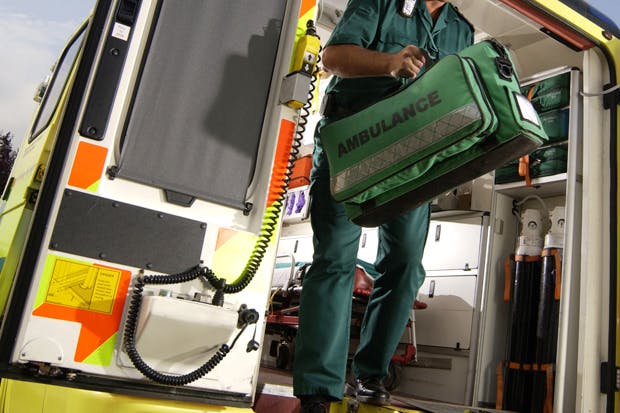Tom leant back against the bathroom wall, his face streaked with blood from the nosebleed, eyes half shut like an owl. ‘I’m passing out,’ he said. Then his legs gave way and he slumped to the floor. ‘Tom? Tom?’ I shook him but — nothing, no response. His hands began an awful looping tremor.
Five minutes before, I hadn’t been much worried, a little bossy even, enjoying playing nursemaid to a friend. It’s only a nosebleed T. Now. Don’t tip your head back, you’ll choke. Lean forward over the sink, pinch your nose. Like this. Here.
As Tom lost consciousness, so my reality changed. This was a different world — one in which T might be having a fit, or dying. My thoughts moved at different speeds. The big ones were insufferably slow: make sure T can breathe. Find phone. Call 999. Smaller, more selfish thoughts darted around them: Oh God. What’s that shaking? Is he epileptic? Why won’t he wake up? Can I bear it? I want to run away. What sort of person even thinks that?
About seven minutes after I called 999, the first paramedic arrived on a motorbike. As he knelt down, T’s eyes opened. A short while later an ambulance arrived and a second paramedic ran through a series of checks. Not a seizure at all, he said, just a sudden, dramatic drop in blood pressure — but we’ll take Tom to hospital to make sure. I can still see the scene: T drooping and bloody, around him the men in green. I felt the sort of surge of gratitude that welds a person forever to the idea of the NHS. To have somewhere to turn when you’ve reached your wits’ end, to be able to call for help without fretting about debt, seemed suddenly to be the very pinnacle of civilisation.
T’s incident was a fortnight ago, but the relief remains, which is why I noticed and read a story last week about a crisis among London’s paramedics. Figures from the London Health Board showed that 238 people left the London Ambulance Service (LAS) in 2013–14. Only 80 left in 2011–2012. That’s an extraordinary increase. Thirty paramedics left in May 2014 alone. I read the whole report which suggested, almost casually, that there could be 600 frontline vacancies across the LAS by the end of this year. Six hundred paramedics down! Why is no one taking this more seriously?
I thought back a fortnight to our ambulance ride, with a chill of selfish fear. T’s is a neighbourhood full of curtain-twitchers. As I helped him out onto the street there was a ripple of net from one end to the other. The surreptitious creak of a sash window lifted, all the better to peer out. Tom said: they’re not voyeurs, just elderly. They worry it’s going to be their turn next. He was right. This is central London, where each council block is a warren of the lonely old. The flats are small and so families have long since moved to the suburbs. As London grows ever bigger, so it grows older too — and the desperate calls to 999 increase. What will we all do when the LAS frontline has crumbled away?
And why are they abandoning us, those heroic men in green? The LAS’s official explanation is that London is expensive and salaries are slim. Paramedics in the capital need more money. But I feel there’s more to this than just cash. Buried in an appendix to the Health Board report is an interesting little table, showing the results of a survey of those paramedics who chose to leave, and as it turns out very few of them mention either pay or stress. Most have chosen not to explain why they’re off. The ‘reasons’ column is simply marked: not known. And those unknowns have cast my mind back to a conversation in the back of the ambulance that day.
All three men — two paramedics and a medically trained ambulance driver — had signed up with a feeling of vocation they said, a desire to help in some way. Pay, though important, wasn’t the point. So what are the downsides of the job? I asked.
Their first real beef was with people who think of calling an ambulance as an alternative to seeing their GP. Despite the existence of the not-quite-emergency 111 line, hundreds of us still call 999 for flu, for minor cuts and headaches. We dial up a paramedic as you might call for a manservant — and it destroys their faith in the public, they said. So they leave, and more fool us.
Then, of course, there’s the drunks. We’re a nation of binge-drinkers, lying around in sodden heaps all nights of the week save Sundays. The ambulance men told me about the LAS’s secret weapon, a special ‘booze bus’ — which cruises about the West End scooping up the pie-eyed. But it wasn’t the use of a booze bus that worried them so much as its misuse.
The LAS, like all ambulance services nationwide, has targets to hit. If a 999 call is designated a Category A, the first responder should be there in eight minutes. The ambulance should turn up in under 19 minutes. On arrival at a hospital, there’s an internal turnaround target time of 30 minutes.
Because it scoops up so many people at a time, and because it cruises around a relatively small and central area, the ‘booze bus’ van has exemplary figures. It’s a target-hitting factory, and so, said the paramedics, the LAS management sometimes swap the figures around. They reallocate and shift results, using the ‘booze bus’ figures to raise the averages of badly performing ambulances elsewhere.
Exactly how and in what way they do this, I have no idea. At the time I didn’t ask for more explanation or press the issue, because we were helping Tom out and then saying goodbye. And I can quite see why it might seem justified: missed targets means fines and fines mean less money to pay paramedics more. From the perspective of management, tweaking the results might be to everyone’s benefit.
But in my brief and very limited experience of the LAS, the frontline is made up of men and women who feel a calling and take pride in saving lives. Fudging figures, perhaps putting patients at risk as a result, will destroy their faith in the profession, and that’s what will really drive them away.
Got something to add? Join the discussion and comment below.
Get 10 issues for just $10
Subscribe to The Spectator Australia today for the next 10 magazine issues, plus full online access, for just $10.















Comments
Don't miss out
Join the conversation with other Spectator Australia readers. Subscribe to leave a comment.
SUBSCRIBEAlready a subscriber? Log in